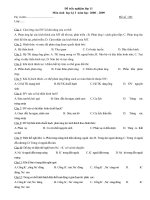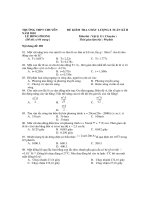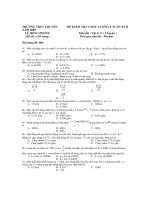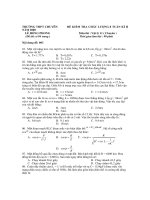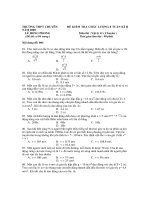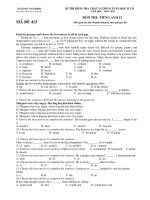ĐỀ KIỂM TRA CHẤT LƯỢNG 8 TUẦN HỌC KỲ I Năm học: 2010- 2011 Môn: Tiếng Anh doc
Bạn đang xem bản rút gọn của tài liệu. Xem và tải ngay bản đầy đủ của tài liệu tại đây (106.35 KB, 3 trang )
SỞ GD-ĐT NAM ĐỊNH
Trường THPT Xuân Trường B
ĐỀ KIỂM TRA CHẤT LƯỢNG 8 TUẦN HỌC KỲ I
Năm học: 2010- 2011 –Môn: Tiếng Anh 12
Thời gian làm bài: 45 phút
Choose the word whose underlined part is pronounced differently from the others in the group.
1. A. farmers B. fields C. vehicles D. crops
2. A. stopped B. followed C. rained D. believed
3. A. marvellous B. argurment C. maximum D. startling
Choose the word with different stress pattern.
4: A. decent B. social C. install D. verbal
5: A. husband B. confide C. unwise D. concern
Choose the best answer.
6: The phone rang while she ______ dinner.
A. is cooking B. has cooked C. was cooking D. cooks
7: Nothing ______ in this town since I first visited it.
A. has changed B. was changing C. changed D. changes
8: - "Could you bring me some water?"
- "______."
A. Certainly, sir B. No, I don't C. I don't want D. No, thanks
9: - "Would you like to go to the cinema with me this weekend?"
- "______."
A. Yes, it is B. Yes, I'd love to C. Yes, I do D. I agree with you
10: Who's going to look ______ the children while you're away?
A. after B. over C. up D. at
11: My sister ______ trouble with her motorbike now, so she has to take the bus to work.
A. had B. have C. is having D. was having
12: A meeting will ______ to discuss the matter.
A. be held B. held C. hold D. have been held
13: Who ______ America about 600 years ago?
A. discovered B. has discovered C. discovers D. was discovering
14: The train………when we arrived at the station.
A. had left already B. has left already
C. was already leaving D. had already left
15: To get someone’s attention, we can use either verbal or …….forms of communication.
A. non-verbal B. nor-verbal C. none-verbal D. no-verbal
16: Whenever problems come………, we discuss them properly to find solutions quickly.
A. down B. out C. across D. up
17: My responsibility is to wash the dishes and ……….the garbage.
A. get out B. take out C. take up D. get up
18: “ Let’s go to the cinema tonight.”- Jane said.
A. Jane wanted us to go to the cinema that night.
B. Jane invited us to go to the cinema that night.
C. Jane allowed us to go to the cinema that night.
D. Jane suggested going to the cinema that night.
19: “What a lovely hat you have” – “Thanks. …………….”
A. I don’t care B. I’m glad you like it C. certainly D. that’s OK
20: Dad is always willing…… a hand …… cleaning the house.
A. to give/ with B. to change/ in C. to help/ in D. to join/ with
21: Shooling is for all children from the age of 6 to 16 in most countries.
A. must B. compulsory C. a duty D. prohibited
22: At the airport, if you are ……to get somebody’s attention, you can wave as hard as you can
A. surprised B. terrified C. frightened D. excited
23 : _ You are a great dancer. I wish I could do half as well as you.
_ ……………………… I am an awful dancer.
A. That’s a nice compliment! B. You’ve got to be kidding!
C. Oh, thank you very much D. You are too kind.
24: It’s not easy to change people’s …………toward a certain problem.
A. opinion B. thinking C. idea D. attitude
25: “Good morning, Mary! How are you?” Henry asked
A. Henry said good morning Mary and asked how was she.
B. Henry greeted Mary and asked how she was.
C. Henry greeted Mary and asked how is she.
D. Henry said good morning and asked Mary how she is.
26: They are whispering to avoid………………by their friends.
A. being heard B. being hearing C. hearing D. to be heard
Identify a mistake from each of the following sentences.
27: When he left, Peter forgot that he put his passport and wallet in his other jacket
A. when B. in C. put D. forgot
28: Graham told Jane that he would see her tomorrow
A. told B. see C. tomorrow D. he
29: The conical leaf hats is said to be a symbol of Vietnamese culture
A. to be B. culture C. of D. leaf hats
30: He asked me how long did it take to get to Paris by train?
A. how long B. did it take C. get to D. by train
Choose the suitable word to fill in each blank.
Janet left high school three months …31…. She wants to continue her study at a University but her parents
are not rich …32 … to send her to the University. Janet is looking for a job. She hopes that she will earn some
money to …33… the financial problem with her parents . She likes meeting people and traveling …34… she
wants to apply for a position as a receptionist or a tourist guide . She reads newspapers and looks through the
“Situations Vacant” columns everyday. She hopes, she …35… a job soon .
31: A. before B. next year C. ago D. then
32: A. much B. too C. enough D. nearly
33: A. provide B. give C. help D. share
34: A. such B. so C. although D. so that
35: A. has found B. finds C. found D. will find
Read the passage carefully and choose the correct answer.
Communication in general is process of sending and receiving messages that enables humans to share
knowledge, attitudes, and skills. Although we usually identify communication with speech, communication is
composed of two dimensions – verbal and nonverbal.
Nonverbal communication has been defined as communication without words. It includes apparent
behaviors such as facial expressions, eyes, touching, tone of voice, as well as less obvious messages such as
dress, posture and spatial distance between two or more people.
Activity or inactivity, words or silence all have message value: they influence others and these others, in
turn, respond to these communications and thus they are communicating.
Commonly, nonverbal communication is learned shortly after birth and practiced and refined throughout a
person’s lifetime. Children first learn nonverbal expressions by watching and imitating, much as they learn
verbal skills.
Young children know far more than they can verbalize and are generally more adept at reading nonverbal
cues than adults are because of their limited verbal skills and their recent reliance on the nonverbal to
communicate. As children develop verbal skills, nonverbal channels of communication do not cease to exist
although become entwined in the total communication process.
36. According to the writer, ________.
A. Nonverbal language is only used by the deaf and the mute.
B. One cannot communicate in both verbal and nonverbal language.
C. Those who can listen and talk should not use nonverbal language.
D People communicate in both verbal and nonverbal language.
37.Which is not included in nonverbal communication?
A words B. spatial distance C. facial expressions D. tone of voice
38.We can learn from the text that ________.
A. nonverbal can never get any responses
B. most people do not like nonverbal communication
C. even silence has message value
D. touching is not accepted in communicating
39.Human beings ________.
A. have learnt how to communicate in nonverbal language through books
B. can communicate in nonverbal language only when they are mature
C. have learnt how to communicate in nonverbal language since a child
D. communicate in nonverbal language much less than they do in verbal language
40.The word reading has a close meaning to ________.
A. looking at the words that are written B. understanding
C. saying something aloud D. expressing
The end
